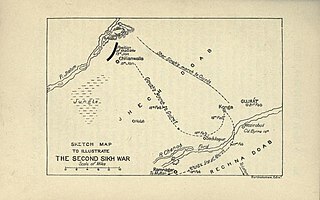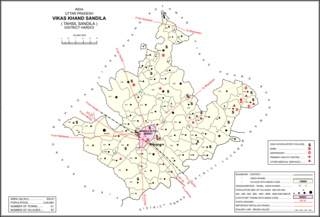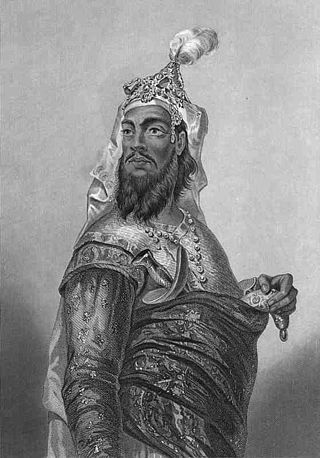Related Research Articles

The Indian Rebellion of 1857 was a major uprising in India in 1857–58 against the rule of the British East India Company, which functioned as a sovereign power on behalf of the British Crown. The rebellion began on 10 May 1857 in the form of a mutiny of sepoys of the company's army in the garrison town of Meerut, 40 mi (64 km) northeast of Delhi. It then erupted into other mutinies and civilian rebellions chiefly in the upper Gangetic plain and central India, though incidents of revolt also occurred farther north and east. The rebellion posed a military threat to British power in that region, and was contained only with the rebels' defeat in Gwalior on 20 June 1858. On 1 November 1858, the British granted amnesty to all rebels not involved in murder, though they did not declare the hostilities to have formally ended until 8 July 1859.

The first Anglo-Sikh war was fought between the Sikh Empire and the British East India Company in 1845 and 1846 around the Ferozepur district of Punjab. It resulted in defeat and partial subjugation of the Sikh empire and cession of Jammu & Kashmir as a separate princely state under British suzerainty.

The second Anglo-Sikh war was a military conflict between the Sikh Empire and the East India Company which took place from 1848 to 1849. It resulted in the fall of the Sikh Empire, and the annexation of the Punjab and what subsequently became the North-West Frontier Province, by the East India Company.

The siege of Cawnpore was a key episode in the Indian rebellion of 1857. The besieged East India Company forces and civilians in Cawnpore were duped into a false assurance of a safe passage to Allahabad by the rebel forces under Nana Sahib. Their evacuation from Cawnpore thus turned into a massacre, and most of the men were killed and women and children taken to a nearby dwelling known as Bibighur. As an East India Company rescue force from Allahabad approached Cawnpore, 120 British women and children captured by the rebels were butchered in what came to be known as the Bibighar Massacre, their remains then thrown down a nearby well. Following the recapture of Cawnpore and the discovery of the massacre, the angry Company forces engaged in widespread retaliation against captured rebel soldiers and local civilians. The murders greatly enraged the British rank-and-file against the Sepoy rebels and inspired the war cry "Remember Cawnpore!".

The Battle of Chillianwala was fought in January 1849 during the Second Anglo-Sikh War in the Chillianwala region of Punjab, now part of modern-day Pakistan. The battle was one of the bloodiest fought by the British East India Company. Both armies held their positions at the end of the battle and both sides claimed victory. The battle was a strategic check to immediate British ambitions in India and a shock to British military prestige.

Hansi, is a city and municipal council in Hisar district in the Indian state of Haryana. It appears that at one time Hansi was larger, more prosperous and more important than Hisar. The town has several important buildings of archeological importance.

The Battle of Gujrat was a decisive battle in the Second Anglo-Sikh War, fought on 21 February 1849, between the forces of the East India Company, and a Sikh army in rebellion against the company's control of the Sikh Empire, represented by the child Maharaja Duleep Singh who was in British custody in Lahore. The Sikh army was defeated by the British regular and Bengal Army forces of the British East India Company. After it capitulated a few days later, the Punjab was annexed to the East India Company's territories and Duleep Singh was deposed.
There were three Burmese invasions of Assam between 1817 and 1826, during which time the Kingdom of Assam came under the control of Burma from 1821 to 1825. Locally, this period, called the manor din by the people of Assam, is remembered with horror. The sharp drop in population due both to depredations as well emigrations left the erstwhile kingdom in shambles. It was the climactic period of the Ahom kingdom. The British, who were earlier reluctant to colonise Assam, came into direct contact with a belligerent Burmese occupying force. Following the First Anglo-Burmese War they annexed Assam and took Manipur as a subsidiary state.
The Central India Campaign was one of the last series of actions in the Indian rebellion of 1857. The British Army and Bombay Army overcame a disunited collection of states in a single rapid campaign, although determined rebels continued a guerrilla campaign until the spring of 1859.
Samana is a town and a municipal council, nearby Patiala City in Patiala district in the Indian state of Punjab.

Sandila is a town and nagar palika parishad in Hardoi district in the Indian state of Uttar Pradesh. It serves as a tehsil headquarters within the district. Located midway between Hardoi and Lucknow, Sandila is a well-connected town with roads leading in all directions and a major broad gauge rail line passing through the south side of town. Important industries include sweets — its laddus are especially well-known — as well as beedi production and zardozi work.
Jiffs was a slang term used by British Intelligence, and later the 14th Army, to denote soldiers of the Indian National Army after the failed First Arakan offensive of 1943. The term is derived from the acronym JIFC, short for Japanese-Indian fifth column. It came to be employed in a propaganda offensive in June 1943 within the British Indian Army as a part of the efforts to preserve the loyalty of the Indian troops at Manipur after suffering desertion and losses at Burma during the First Arakan Offensive. After the end of the war, the term "HIFFs" was also used for repatriated troops of the Indian Legion awaiting trial.

Kunwar Singh, also known as Babu Kunwar Singh was a chief organiser of the Indian Rebellion of 1857 from the Bhojpur region of Bihar. He was originally the ruler of Jagdishpur principality. He led a selected band of armed soldiers against the troops under the command of the British East India Company.

The Battle of Najafgarh was a subsidiary engagement of the Siege of Delhi during the Indian Rebellion of 1857. A large Indian force sortied from Delhi, intending to attack the rear of the British force besieging the city. A detachment from the besiegers marched to intercept them, and defeated them while they were disordered by difficult terrain and by quarrels among their commanders.
Bariawas is a village in Rewari mandal of Rewari district in the Indian state of Haryana. It is near Chhuriawas village Rewari at about 8.3 kilometres (5.2 mi) on the approach Rewari- Garhi Bolni Road.

The Battle of Gurdas Nangal took place in April 1715 between the Sikhs, led by Banda Singh Bahadur, and the Mughal Army, led by Abd al-Samad Khan. Banda, at that time was carrying out operations and small raids to the north of Amritsar. During these operations, the Mughal Army confronted the Sikhs. When confronted, the Sikhs moved northward taking shelter in the fort of Gurdaspur. It had been recently extended to accommodate 60,000 horses, and stores of food, grain and fodder had also been collected there. The Mughal Army converged upon the fort from three sides. The Delhi force of 20,000 men under Qamar-ud-din Khan advanced from the east. The Governor of Lahore’s troops, consisting of 10,000 men under Abd al-Samad Khan, marched from the south. Finally, Jammu troops numbering nearly 5,000, under Zakariya Khan, approached from the north. To the west of the fort was the River Ravi, which had no bridge over it. All the boats had been withdrawn to the opposite bank, which was closely guarded by numerous local chiefs and Mughal government officials. The Mughal pursuit made it so the Sikhs could not enter the fort at Gurdaspur. Thus, the Sikh army quickly turned west.
Maharaja Fateh Bahadur Shahi was 99th Raja of Huseypur or Hathwa Raj situated in today's Gopalganj district of Bihar in India. He relentlessly pursued his objective of driving them out for nearly three decades while waging a guerilla war against the British. The British used all of their might and resources to oppose him.
Ahmadullah Shah famous as the Maulvi of Faizabad, was a famous freedom fighter and leader of the Indian Rebellion of 1857. Maulavi Ahmadullah Shah was known as the lighthouse of the rebellion in the Awadh region. British officers like George Bruce Malleson and Thomas Seaton made mentions about the courage, valour, personal and organizational capabilities of Ahmadullah. G. B. Malleson mentions Ahmadullah repeatedly in the History of Indian Mutiny, a book written in 6 volumes covering Indian revolt of 1857. Thomas Seaton describes Ahmadullah Shah as:
A man of great abilities, of undaunted courage, of stern determination, and by far the best soldier among the rebels.

Rafa'at wa Awal-i-Martabat Maharaja Shri Chet Singh Sahib Bahadur, commonly known as Raja Chet Singh, a Bhumihar Brahmin king from the Narayan dynasty, was 3 rd ruler of Kingdom of Benaras in northern India.
The Chero dynasty or Chyavana dynasty was a polity that ruled the northern regions of the Indian subcontinent, corresponding to the present-day Indian states of Bihar, Uttar Pradesh, and Jharkhand, after the fall of the Pala Empire; their rule lasted from the 12th century CE to the middle of the 15th century.
References
- ↑ "Untold Story of Narpati Singh". Patrika.